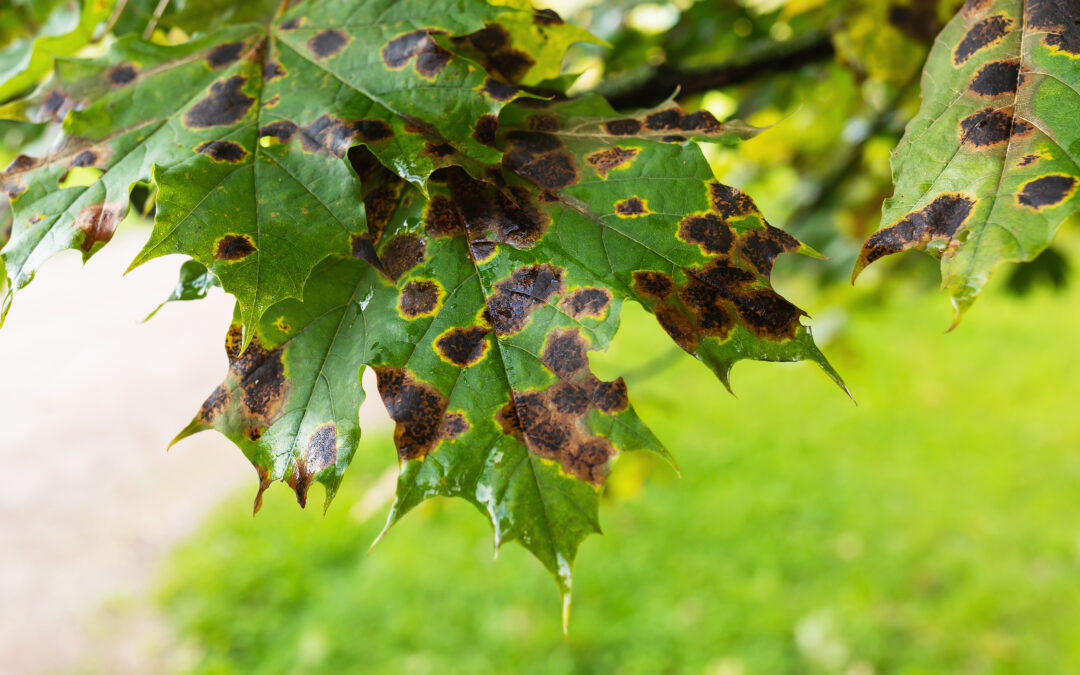Utah’s climate brings four beautiful seasons but it also creates the perfect environment for several tree diseases that can weaken or kill your landscape trees. From fungal infections to needle blights, many issues start small yet become serious if left untreated. Knowing how to identify early symptoms can save you time, money, and the risk of losing a mature tree. With the right tree care services, you can address issues before they worsen. Below are the most common tree diseases in Utah and how to spot them before they spread.
Anthracnose
Anthracnose is one of the most widespread fungal diseases in Utah, especially affecting maples, ash, oaks, and sycamores.
How to identify it:
- Brown or tan spots forming along leaf veins
- Leaf curling or distortion
- Early leaf drop in late spring or early summer
- Twigs at the tips of branches dying back
Why it matters:
If the same tree is infected year after year, it becomes weaker and more susceptible to other problems like pests and drought stress.
Aspen Leaf Spot
Common in Utah’s many quaking aspen trees, this disease is caused by fungi that thrive in cool, moist conditions.
Signs to look for:
- Small brown spots that expand into large blotches
- Leaves turning yellow prematurely
- Thinning canopy during mid-summer
Why it’s a concern:
While one season may not kill a tree, repeated infections weaken aspens and can cause entire stands to decline.
Dothistroma Needle Blight (Pines)
This disease affects many pine species across Utah, especially Austrian and ponderosa pines.
How to spot it:
- Needles turning brown from the tip backward
- Distinct red or dark bands across needles
- Thinning needles and sparse branch tips
Impact on trees:
Severe needle loss stresses the tree and can eventually lead to decline or death if not managed.
Cytospora Canker
Often found in spruces, aspens, willows, and poplars, this fungal infection enters through wounds or stressed areas of the tree.
Symptoms include:
- Sunken, discolored patches on bark
- Oozing resin or sap that appears amber or orange
- Dead branches starting from lower limbs upward
Why it’s serious:
Once the fungus spreads, entire limbs can die back. Early detection is critical because treatment options are limited once cankers expand, making professional tree health care essential for preventing further decline.
Oak Leaf Blister
Oak trees in Utah frequently experience this springtime fungal disease.
What to look for:
- Raised, blister-like bumps on leaves
- Leaf curling, puckering, or discoloration
- Premature leaf drop in late spring
Long-term risk:
Repeated infections reduce vigor and make the tree more vulnerable to drought and pests.
Other Tree Health Issues to Watch For
Iron Chlorosis
Many Utah soils are alkaline, making it hard for trees like maples, oaks, and aspens to absorb iron. Leaves turn yellow while veins remain green.
Leaf Scorch
Hot, windy summers cause leaf edges to brown and curl due to moisture stress.
Fire Blight
A bacterial disease affecting apples, pears, and ornamental fruit trees. Branches appear “burned” or wilted.
Protecting Your Trees Starts with Early Detection
Noticing unusual spots, thinning canopies, or branch die-back is the first step toward getting your trees healthy again. Because tree diseases spread quickly and often look similar, professional diagnosis and proper tree care services are the best way to prevent long-term damage.
At Nyes Tree Service, we provide expert disease identification, proper pruning, preventive treatments, and recommendations tailored to Utah’s climate and soil conditions. Whether you’re concerned about a single tree or managing multiple acres, our team can help restore your trees to full health.
Need a tree health evaluation? Contact Nyes Tree Service today for professional assessment and treatment options.

